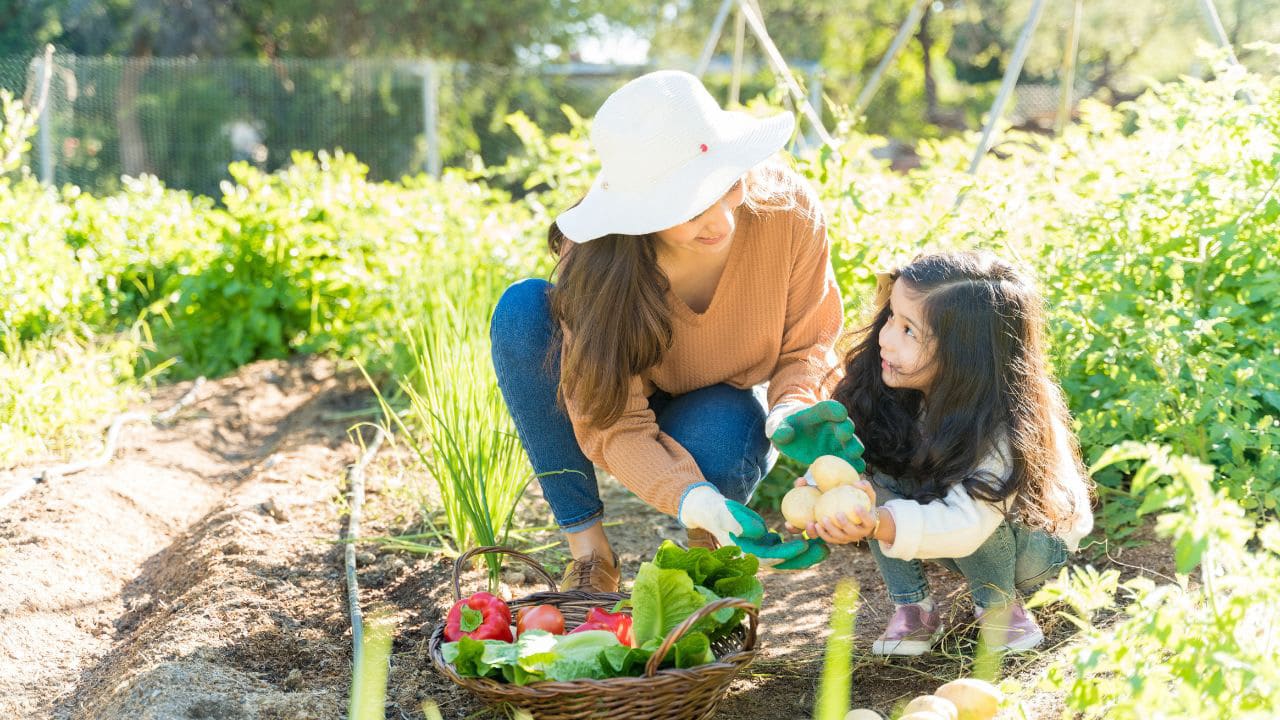Building memories and foundations for your family typically surround spending quality time together. If you are looking for new ways to build positive and healthy habits together, try planting a family garden. Not only is it an easy activity to engage in, but also teaches your child life lessons through experiential learning. They will learn responsibility, the benefit and ease of eating fresh foods, sense of accomplishment, and staying active (to name a few). How will you get started? We have you covered thanks to these tips from VeryWell Family.
Whether you have an acre of land or a few pots on a balcony, gardening as a family helps you all live healthier. Gardening is an easy activity to share, and you'll harvest many benefits along with your fresh vegetables, colorful flowers, and aromatic herbs. Even better, you don't have to wait for your plants to bloom to see those benefits. Some of them, like stress relief,1 family bonding, and fun, are almost instantaneous.
Benefits of a Family Garden
When parents and kids work together to plant and care for a garden, they can all enjoy these perks.
Physical Activity
Gardening and yard work are moderate-intensity exercises, which we all need every day. Kids ages 3 to 5 need to get three hours of physical activity each day, and older kids need a minimum of an hour daily.2 While tending your family garden doesn't require the vigorous activity of, say, running or playing singles tennis, it's still beneficial to your body.3
Gardening gets you outside and moving. Promote more activity for your child by asking them to bring you various tools, such as a bucket, shovel, or hose. The actual gardening work can also be quite demanding. Additionally, once in the yard or garden plot, your little one is likely to begin engaging in more active play when not actively gardening.
Once you start gardening, it's common to continue for 30 minutes or more. And gardening incorporates fine-motor skill strengthening and stretching.
Lower Stress, Better Mood
Gardening is an excellent stress reliever for a combination of fascinating reasons: exposure to fresh air and sunlight, performing relaxing and repetitive tasks, and even contact with harmless bacteria in the soil that helps release serotonin in the brain.4
Outdoor Time
Children are prone to spending a lot of time indoors, which can negatively affect their behavior and health. Research indicates that time spent in nature offers significant mental health benefits for children.5 A family garden gets them outside enjoying and experiencing the natural world.
Better Sleep
All of the above (physical activity, reduced stress, being outside) can contribute to more and better sleep for everyone. And better sleep, in turn, can improve kids' behavior, health, performance at school, and general well-being.6
Healthier Eating
Kids who grow vegetables tend to eat more vegetables. Or at least, they may be more willing to taste unfamiliar veggies, which is the first step to incorporating new flavors into their diet. Adults who garden are also more likely to eat more fruits and vegetables than non-gardeners.4
Family Time
Gardening is a great family activity that can promote family closeness. Planning, sowing, and tending a family garden offers a shared purpose for everyone. Working together on a meaningful project strengthens and reinforces your bonds. Gardening helps teach kids responsibility and gives them a sense of accomplishment.
Projects for Your Family Garden
Consult with an expert neighbor, a family member, a local nursery, or a cooperative extension service to find out what plants will grow best where you live. Internet searches will also help you pinpoint what will thrive in your available gardening space. You might invest in a rain barrel and start a compost pile to make your garden more Earth-friendly, too.
Vegetables
Start them from seed, or purchase seedlings to get a jump-start. If your kids have a favorite vegetable, it's definitely worth letting them try to grow their own. You can find favorites like carrots, string beans, bell peppers, and potatoes in kid-appealing purple hues. Tomatoes, too, come in dozens of colors, shapes, and sizes.
Quick-growing plants, such as radishes, peas, cucumbers, and many herbs, are satisfying for kids to grow. If your children are very small, it's easier for them to plant veggies with larger seeds, like peas, corn, and beans.
Flowers
There are lots of options for involving kids in flower gardening. Let them pick out some seeds based on the pretty pictures on the packets. Or opt for drama with easy-to-grow sunflowers, which can reach as high as eight feet tall.
Simple daisies produce lots of blooms for kids to enjoy, display, and craft with. Other blooms that are easy to grow (and thus less likely to lead to disappointment) are marigolds, snapdragons, and geraniums.
You might also decide to plant with a goal in mind, such as creating a butterfly garden full of plants that attract and nourish butterflies. You'll get the satisfaction of growing beautiful things while welcoming beautiful creatures.
Fruits
Fruit trees can be difficult to care for and may take several years to yield a harvest. But strawberries are a snap to grow from seeds or seedlings, and blackberries or raspberries can also be an option (plus they're perennial and will come back year after year). If you live in a very warm climate or keep them indoors, you can grow your own citrus fruits, too.
Creative Ways to Share Gardening
If you have limited outdoor space, planting in containers is a good way to try out gardening. If you don't have a yard or any place to put containers, consider planting an indoor garden or window planters. Even if you do have space, starting with containers can be a good introduction to gardening for little ones.
Another option is to work in a community garden, which may mean renting a plot or sharing in the work for a communal harvest. Community gardening opportunities vary widely, so it may take a bit of local research to find out what options are available. Contact your local city officials and/or the American Community Gardening Association for help connecting to available resources in your community.
Additionally, consider if you know someone who has a garden. You may be able to collaborate with a friend or neighbor who might be enthusiastic about having some regular garden helpers.
Family Garden Chores for Kids
Kids can do a lot of the work for your family garden, either independently or alongside an adult. While you don't want them to burn out on tedious tasks like weeding, helping out and taking responsibility is part of what makes a family garden meaningful. Set a goal, such as clearing one small, designated area or working for 15 or 20 minutes, then do something else for a break between chores.
Depending on their ages, kids can:
- Bring compostable waste to the compost pile
- Collect sticks and other debris
- Dig holes for seeds or plants
- Harvest fruits or vegetables
- Mow the lawn (age 10 and up)
- Pull weeds (with good instructions on what to pluck and what to keep)
- Rake leaves
- Snip flowers for a bouquet
- Spread bark or mulch
- Sprinkle plant food
- Water plants
Photo: Antonio_Diaz from Canva/Getty Images

